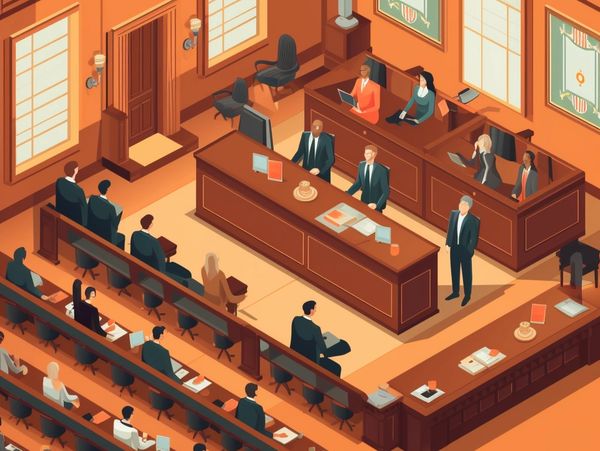Vital Skills for Crafting Convincing Trial Presentations: A Comprehensive Overview
Vital Skills for Crafting Convincing Trial Presentations: A Comprehensive Overview
Blog Article
Browsing the Intricacies of Test Presentations: Tips for Seamless Shipment and Engaging Debates
In the realm of legal procedures, the art of test presentation stands as a vital component of success. The intricacies inherent in test presentations need a delicate balance of skill, method, and skill.

Understanding Test Goals
To efficiently navigate a trial, it is critical to have a clear understanding of the goals that need to be achieved. Before entering the courtroom, legal teams need to specify their goals and preferred end results. These purposes act as directing concepts throughout the test, forming strategies and affecting decision-making procedures.
Comprehending test goals involves a thorough analysis of the instance, lawful precedents, and the customer's benefits. Trial Presentations. It calls for a careful examination of the truths, recognizing essential problems, and expecting potential obstacles. By establishing certain and quantifiable goals, lawyers can customize their debates and discussions to straighten with the desired outcomes
Additionally, a clear grip of test objectives makes it possible for lawful groups to prioritize proof, witnesses, and legal disagreements effectively. It enables for the advancement of a coherent story that resonates with the court and court, strengthening the total case presentation.

Organizing Proof Successfully
Having a clear understanding of test purposes lays the foundation for arranging proof properly in legal process - Trial Presentations. By lining up the discussion of evidence with the desired results of the trial, legal groups can strengthen their arguments and boost their persuasiveness. One important aspect of organizing evidence is categorization. Grouping evidence based upon motifs or relevance to details lawful elements can aid simplify the discussion and make complex information extra digestible for the judge or court.
One more key element in arranging evidence efficiently is developing a sensible flow. Providing evidence in a meaningful and consecutive way can aid develop a compelling narrative that sustains the legal disagreements being made. In addition, utilizing aesthetic help such as charts, graphs, or timelines can additionally enhance the organization of proof and aid in clarifying complicated partnerships or sequences of events.
Moreover, ensuring that all evidence provided is permissible and pertinent to the instance is essential. Unimportant or inadmissible proof can interfere with the strength of the disagreement and potentially hurt the reputation of the presenting party. As a result, a thorough testimonial and option procedure should be undertaken to include only the most lawfully sound and impactful evidence in the trial presentation.
Crafting Convincing Narratives
Crafting compelling stories plays a critical duty in presenting influential debates throughout legal proceedings. When constructing a narrative for a trial discussion, it is vital to develop a clear story that highlights key points and connects them in a systematic way. By weaving together proof, testimony, and legal arguments into a natural and persuasive story, lawful experts can successfully support for their clients and boost the possibility of a positive end result in the courtroom.
Mastering Aesthetic Aids
Effective use of aesthetic aids is essential to boosting the effect and clearness of test presentations. Visual help, when used strategically, have the power to simplify intricate info, reinforce bottom lines, and leave a lasting impact on the discretionary. To master aesthetic aids in trial presentations, it is critical to make certain that they are clear, concise, and appropriate to the debates being made.
When incorporating aesthetic help, such as graphes, charts, timelines, or photos, into a test discussion, it is essential to keep them visually appealing yet professional. The visuals ought to match the verbal disagreements, offering an aesthetic representation of the info being gone over without overwhelming the audience with unnecessary details.
Furthermore, experimenting the visual help ahead of time is essential to guarantee a seamless delivery throughout the test. Acquainting oneself with the material, transitions, and timings of each visual help can aid preserve the flow of the presentation and prevent technological problems that may occur.
Delivering Impactful Closing Arguments
A compelling closing disagreement serves as the culmination of a trial presentation, enveloping the core story and encouraging the court and jury towards a beneficial decision. Begin by describing the major arguments that support your client's position, emphasizing why the proof provided throughout the test supports your narrative.
Moreover, including sob story can additionally strengthen your closing disagreement. By humanizing the case and attaching on an individual level with the decision-makers, you can stimulate empathy and understanding, influencing their perception of the realities presented. Furthermore, stating the legal criteria that have to website here be met for a positive judgment can reinforce the credibility of your placement. Inevitably, a well-crafted closing argument ought to leave an enduring impact, engaging the judge and jury to rule in your customer's support.
Final Thought
Finally, mastering test presentations involves recognizing purposes, organizing evidence, crafting stories, utilizing aesthetic aids, and delivering impactful closing arguments. By executing these techniques efficiently, legal representatives can offer their case effortlessly and make compelling debates in the court room. It is important to browse the complexities of trial presentations with precision and navigate to these guys skill to accomplish success in lawful procedures.
By aligning the presentation of proof with the desired end results of the test, legal teams can strengthen their arguments and enhance their persuasiveness (Trial Presentations). To grasp visual help in test presentations, it is crucial to make certain that they are clear, succinct, and relevant to the disagreements being made
A compelling closing disagreement serves as the end result of a test presentation, encapsulating the core story and persuading the judge and court in the direction of a beneficial choice. Begin by laying out the major arguments that support your customer's position, highlighting why the proof provided throughout the trial supports your narrative.In find out here verdict, understanding test presentations entails understanding purposes, organizing proof, crafting stories, making use of aesthetic aids, and supplying impactful closing disagreements.
Report this page